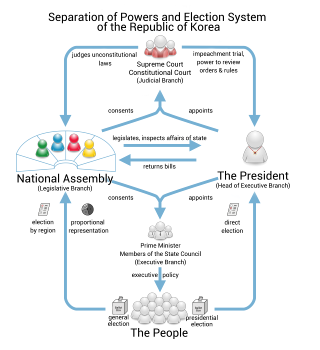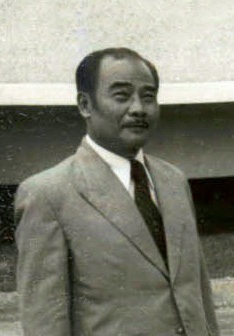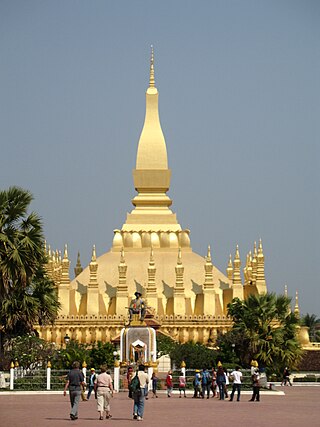Political party in Laos
 |
|---|
|
|
The Lao Development Association was a political party in Laos.
 |
|---|
The Lao Development Association was a political party in Laos.
The party began as the Southern Bloc, a conservative group led by Leuam Insisiengmai and Boun Oum, and won 15 seats in the 1965 elections, emerging as the largest party. [1] Once in parliament, it formed the core of the Group of Thirty-Three. [2]
The Group of Thirty-Three helped vote down the 1966 budget, [2] leading to early elections in 1967. Following the elections the party was renamed the Lao Development Association. It was heavily defeated in the 1972 elections. [2]

Laos, officially the Lao People's Democratic Republic (LPDR), is the only landlocked country in Southeast Asia. It is bordered by Myanmar and China to the northwest, Vietnam to the east, Cambodia to the southeast, and Thailand to the west and southwest. Its capital and most populous city is Vientiane.

The politics of the Lao People's Democratic Republic takes place in the framework of a one-party parliamentary socialist republic. The only legal political party is the Lao People's Revolutionary Party (LPRP). The head of state is President Thongloun Sisoulith, who is also the LPRP general secretary, making him the supreme leader of Laos. The head of government is Prime Minister Sonexay Siphandone.

The politics of South Korea take place in the framework of a presidential representative democratic republic, whereby the president is the head of state, and of a multi-party system. To ensure a separation of powers, the Republic of Korea Government is made up of three branches: legislative, executive, and judicial. The government exercises executive power and legislative power is vested in both the government and the National Assembly. The judiciary is independent of the executive and the legislature and comprises a Supreme Court, appellate courts, and a Constitutional Court.

Prince Souphanouvong, nicknamed the Red Prince, was along with his half-brother Prince Souvanna Phouma and Prince Boun Oum of Champasak, one of the "Three Princes" who represented respectively the communist (pro-Vietnam), neutralist and royalist political factions in Laos. He was the President of Laos from December 1975 to October 1986.

The Lao People's Revolutionary Party (LPRP) is the founding and sole ruling party of the Lao People's Democratic Republic. The party's monopoly on state power is guaranteed by Article 3 of the Constitution of Laos, and it maintains a unitary state with centralised control over the economy and military.

The president of the Lao People's Democratic Republic is the head of state of Laos. The current president is Thongloun Sisoulith, since 22 March 2021. He was previously elected as the General Secretary of the Lao People's Revolutionary Party, Laos' most powerful position in January 2021, ranking him first in the Politburo.

Theravada Buddhism is the largest religion in Laos, which is practiced by 66% of the population. Lao Buddhism is a unique version of Theravada Buddhism and is at the basis of ethnic Lao culture. Buddhism in Laos is often closely tied to animist beliefs and belief in ancestral spirits, particularly in rural areas.

The Isan people or literally Northeastern people are an ethnic group native to Northeastern Thailand with an estimated population of about 22 million. Alternative terms for this group are T(h)ai Isan, Thai-Lao, Lao Isan, or Isan Lao. Like Central Thai (Siamese) and Lao, they belong to the linguistic family of Tai peoples.

Dobama Asiayone, commonly known as the Thakins, was a Burmese nationalist group formed around the 1930s and composed of young, disgruntled intellectuals. Drawing their name from the way in which the British were addressed during colonial times, the party was established by Ba Thaung in May 1930, bringing together traditionalist Buddhist nationalist elements and fresh leftist political ideals. It was significant in stirring up political consciousness in Burma, and drew most of its support base from students.

Laotian women have long been active participants in their nation's society, involved in politics, driving social transformation and development, becoming active in the world of business and serving as nurses and food producers for the military. Due to modernization and rural uprooting, Lao women have begun to embrace lifestyles that are foreign to traditional Laotian ideals.

The Independent Party was a political party in Laos.

The Democratic Party was a political party in Laos.

The Lao National Union Party was a Buddhist Socialist political party in Laos.

The Peace and Neutrality Party was a political party in Laos.

The Lao People's Rally was a political party in Laos.

The Lao Neutralist Party was a political party in Laos. It published the Say Kang newspaper.

The Association of Northern Deputies was a political party in Laos.
The Sarawak Chinese Association was a political party in the Sarawak state of Malaysia.
The 11th National Congress of the Lao People's Revolutionary Party (LPRP) was held in Vientiane from 13 to 15 January 2021. The congress occurs once every five years. A total of 768 delegates represented the party's nearly 350,000 card-carrying members. The intention of the meeting was, according to LPRP General Secretary Bounnhang Vorachit, to "review together the implementation of the resolution of the 10th National Party Congress and generally evaluate the creating of foundations for marching toward socialism over the past years; learn useful lessons and make agreement on directions, policy and guidance on the national socio-economic development plan for years to come to ensure the continued nurturing of people’ democratic regime and creating of foundations for marching toward socialism".

Kaysone Phomvihane Thought is a political ideology that builds upon Marxism–Leninism and Ho Chi Minh Thought with the political philosophy developed by Kaysone Phomvihane, the first leader of the Communist Lao People's Revolutionary Party (LPRP). It was first formalised by the LPRP at its 10th National Congress, held in 2016. The ideology includes views on the basic issues of the Laotian Revolution, specifically the application and development of Marxism–Leninism to the material conditions of Laos. The contents of Kaysone Phomvihane Thought was codified and developed by the LPRP with help from the Communist Party of Vietnam.